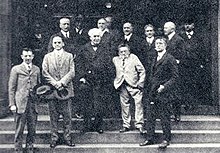William David Coolidge
William David Coolidge (born October 23, 1873 in Hudson (Massachusetts) , † February 3, 1975 in Schenectady , New York ) was an American physicist.
Coolidge studied at the Massachusetts Institute of Technology (MIT), where he designed an X-ray generating device as early as 1896 . A scholarship took him to Leipzig from 1896 to 1899 , where he also received his doctorate. After returning to Massachusetts, he taught at MIT before joining General Electric's research laboratory at Schenectady in 1905 . In 1932 he became director of the research institute, which he headed until he left in 1944.
William David Coolidge developed malleable tungsten wires that were used as filament coils in incandescent lamps . These spiral-shaped tungsten wires were also used by him in 1913 in the Coolidge tube named after him , a hot-cathode vacuum tube through which X-rays were released. This tube with reproducible radiation (intensity and radiation quality) became the forerunner of almost all medical X-ray tubes still used today, even if their development continued until the mid-1940s.
Coolidge also worked on tracking devices for submarine detection during World War I, but then focused his work again on X-ray technology, where he also worked in the fields of materials testing and cancer treatment.
Awards
- 1915: Member of the American Academy of Arts and Sciences
- 1925: Member of the National Academy of Sciences
- 1927: AIEE Edison Medal
- 1938: Member of the American Philosophical Society
- 1939: Faraday Medal (IEE)
- 1963: X-ray badge from the city of Remscheid
literature
- Ainissa Ramirez: Tungsten's Brilliant, Hidden History In: American Scientist , March – April 2020, pp. 88–91
- K. Jäger, F. Heilbronner (eds.): Lexikon der Elektrotechniker , VDE Verlag, 2nd edition from 2010, Berlin / Offenbach, ISBN 978-3-8007-2903-6 , pp. 89-90
Individual evidence
- ↑ Patent US1082933 (pdf)
| personal data | |
|---|---|
| SURNAME | Coolidge, William David |
| BRIEF DESCRIPTION | American physicist |
| DATE OF BIRTH | October 23, 1873 |
| PLACE OF BIRTH | Hudson, Massachusetts |
| DATE OF DEATH | 3rd February 1975 |
| Place of death | Schenectady , New York |
